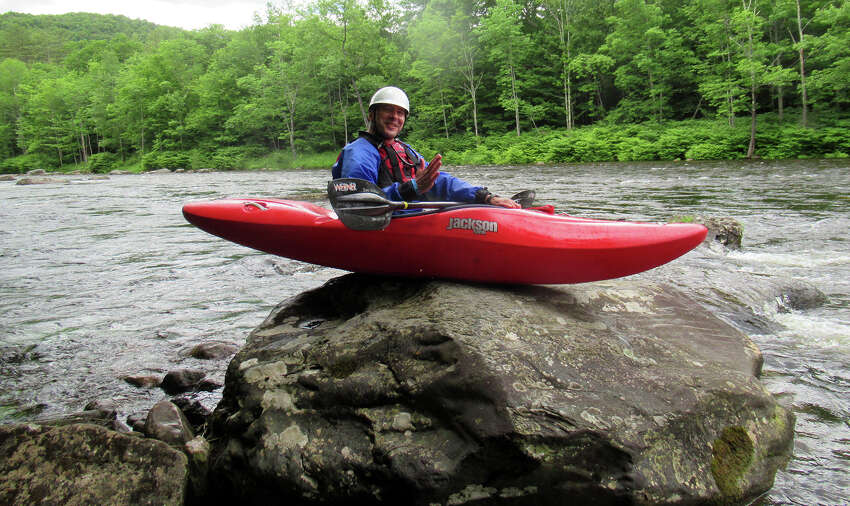I stood high on the banks of the Zoar Gap outside Charlemont, Mass. Below me, the Deerfield River roared through car-sized boulders.
I watched kayaks navigate the Class III rapids. The boats were all different sizes and colors. A red boat zipped through a line in the middle of the river, then a black boat turned in an eddy halfway down to watch his buddy come through the rapids. A bright green boat got trapped in a hydraulic.
I was safe and dry on the bank but my pulse quickened as I imagined myself in the cockpit of that green kayak. He went through several strokes to break free but the river decided his fate, ending the suspense by flipping him so he made the remainder of the journey through the rapids without his boat.
With a wetsuit, a personal flotation device and a helmet, I was dressed like a white-water kayaker, but I was a pretender, part of a novice whitewater clinic run by nearby Zoar Outfitters.
A novice is someone inexperienced or untrained. It’s a label most of us don’t like but it’s the starting line to something new. I ate and slept a lot in the first 25 years of my life but not so much that I don’t have to eat or sleep now. Learning is the same. I learned some things in my first 25 years but there is always room for more if you have the appetite.
My whitewater instructor for the weekend, Riley, was 18 years old. That’s not an expression or an overstatement for comedic effect, he’s 18.
Riley is friendly, encouraging and thoughtful. We practiced on a small pond as he explained the differences between a flatwater kayak and the whitewater kayak I found nearly impossible to paddle in a straight line.
On the short drive from the practice pond to the Deerfield River, Riley explained how the boats have changed in materials and form. How the boat’s edges have been developed so it can turn just by leaning the right way. I wondered how he can only be 18 and know so much.
Mercifully, we didn’t go to the Zoar Gap but instead to a quieter section of the Deerfield called Fife Brook. It’s famous for being the perfect place for fledgling paddlers like me.
Riley and I pushed our boats into a gentle eddy. There were riffles but the river looked almost gentle compared to Zoar Gap. I paddled to the main channel for my first conversation with the Deerfield. I said the wrong thing, leaned the wrong way and flipped the boat. I sat upside down and underwater in a sealed boat. I remembered Riley’s instructions to tuck my body, pull the tab on the whitewater skirt, and perform a “wet exit.”
Kayakers call this “swimming.” Riley told me, for everyone from beginner to expert, it’s part of the sport. “We’re all between swims,” he says, “all of us.”
We make our way down the river and Riley shows me how to lean to get the boat to turn. I turned my shoulders to make it look like I was leaning, but like other parts of life, I was only really fooling myself. Before long, Riley realized I was afraid to flip the boat again and called me on my fake leans.
One day of paddling but I still developed bad habits, falling in love with a backstroke that helped straighten the boat. The backstroke works well going downstream but robbed my forward momentum when paddling upstream.
Riley and I finished the day by paddling upstream from eddy to eddy. My arms were like overcooked fettuccine, my mind aware he was trying to break me of my bad habit backstroke.

On my second day of paddling, we set out on a quiet section of river before the noon recreational dam release. Riley spread floating buoys and I slalomed them. After a few runs, he only allowed one turning stroke per buoy, no backstrokes. It was going to be that kind of day.
We ran more of the river the second day, exciting paddling through Class II rapids and I managed to stay in the boat with a big smile on my face. At a place on the river called “Pinball,” Riley found two calm eddys separated by a lively current. He had me “ferry” between eddys, keeping my boat pointed upstream against the current. Through several tries, I failed to make the round trip, repeatedly losing the bow and getting swept downriver against my will.
“This is where I stop telling you what a great job you’ve been doing,” Riley told me. “This is where I challenge you.”
Again, I tried the ferry. Again, I made it halfway. Again, I started losing the bow on the way back to shore. This time, I fought to keep the bow from getting swept downstream. I paddled as hard as I could. Eventually, the river turned me sideways and I flipped the boat.
Underwater and upside down in my kayak, I realized what he was trying to teach me before I even exited and it wasn’t about ferries. We’re all between swims.
If you go
There are multiple outfitters on the Deerfield River. Zoar Outfitters is on Rt. 2 about 20 miles east of Williamstown, Mass. COVID-19 has impacted class sizes but whitewater clinics are running on summer weekends and some weekdays. http://zoaroutdoor.com
"between" - Google News
June 19, 2020 at 06:19AM
https://ift.tt/2YedL3u
Outdoors: Learning what you can between swims - Times Union
"between" - Google News
https://ift.tt/2WkNqP8
https://ift.tt/2WkjZfX
Bagikan Berita Ini















0 Response to "Outdoors: Learning what you can between swims - Times Union"
Post a Comment